You may have cooked brisket before, but chances are you’ve never made it quite like this. This recipe for West African-Style Brisket comes from the kitchen of my friend Michael Twitty, a culinary historian and author of The Cooking Gene. His dish combines the Jewish holiday tradition of Passover brisket with a blend of African-inspired spices and ingredients. After a slow roast in a low oven, a tender, garlicky and flavorful brisket emerges with just the right amount of spice.
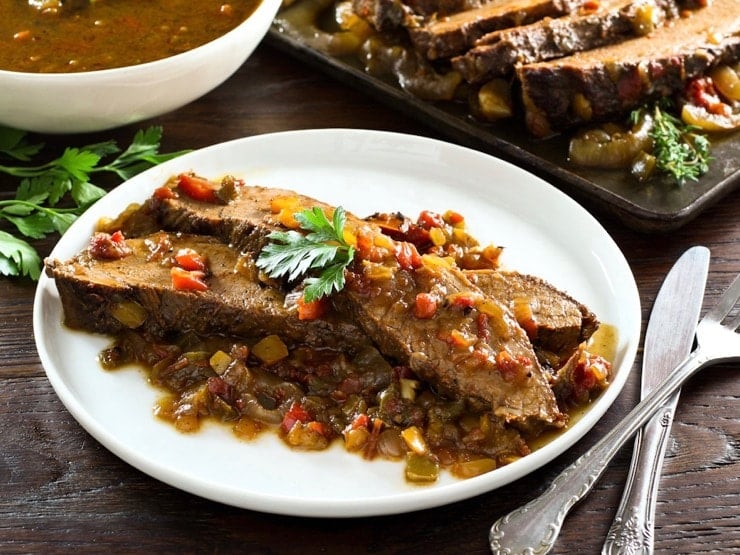
During Passover last year, I had the pleasure of hosting Michael Twitty in our home. He joined us for our seder and shared some of his recipes, traditions, and a wealth of food history knowledge. Michael is a a culinary historian, community scholar, and living history interpreter focusing on historic African American food and folk culture. He has found a unique culinary balance between his Southern roots, his African-American ancestry, and his Jewish faith. The results of this endeavor are a wealth of illuminating scholarly work and some very unique, tasty recipes.
The recipes Michael develops are often recognizably Jewish, but with spices and ingredients inspired by Africa and the American south. Some of his creations include matzo meal fried chicken, peach cobbler kugel, black eyed pea hummus, and schug made with heirloom African American peppers. It’s truly a pleasure to see how Michael connects all of these traditions in the kitchen.
Last Passover we served Michael’s West African-Style Brisket. His inspiration in creating this dish comes from the flavors of Nigeria, Senegal, Eastern Europe and the Mediterranean. The dry spice mixture is Michael’s take on suya, a West African blend dating back to the days of the medieval salt and gold trade. It is spicy and delicious, with layers of unexpected flavor.
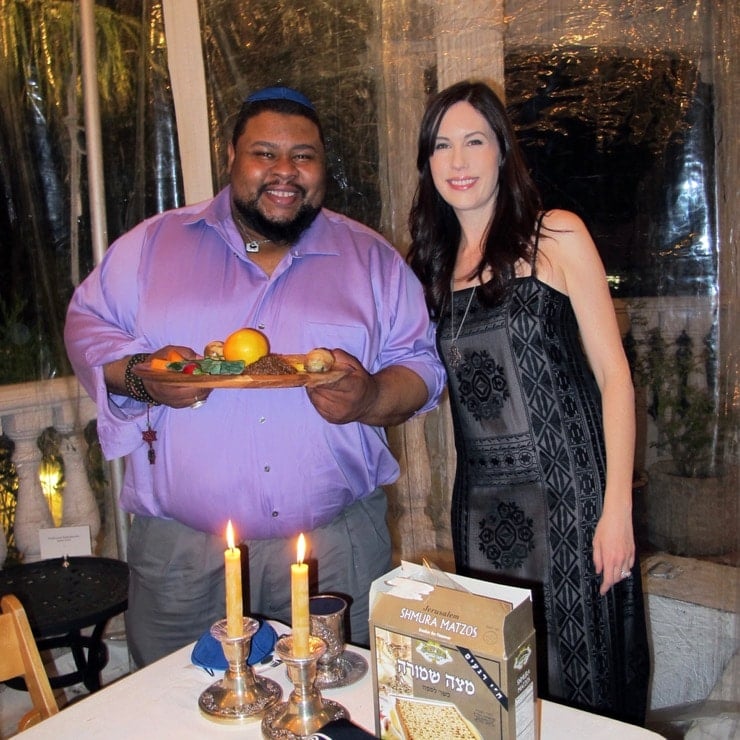
Together with Michael Twitty at our family Passover Seder, 2017
I adapted Michael’s recipe a bit, throwing in a few of my own tried-and-true brisket preparation techniques. This adaptation got Michael’s stamp of approval (no small thing!), and I am thrilled to have another delicious brisket recipe in our family repertoire.
As a season of spiritual rebirth, Passover is a time to honor our ancestors by telling their stories. There are parallels between the horrors of African American slavery and the plight of the Ancient Israelites. Connecting to our shared history allows us to see an ancient biblical story through new eyes. Together, at the seder table, we have an opportunity to absorb the important lessons in our history and carry them forward in our daily lives.
If you share this recipe at your own Seder table, be sure to let your guests know about Michael’s wonderful book The Cooking Gene. Michael and his book just won a major award from Barnes and Noble, among many other impressive accolades this past year. (Update – he also won the James Beard Award!) You can learn more about it here.
Recommended Products:
The Cooking Gene by Michael Twitty
We are a participant in the Amazon Services LLC Associates Program, an affiliate advertising program designed to provide a means for us to earn fees by linking to Amazon.com and affiliated sites. As an Amazon Associate I earn from qualifying purchases.
Hungry for more? Find me on Facebook, Twitter, Pinterest, YouTube and Instagram for all the latest updates!
Food Photography and Styling by Kelly Jaggers
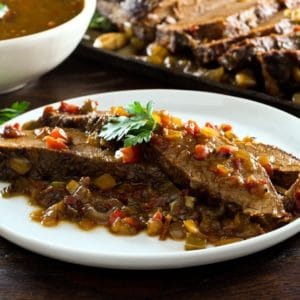
West African-Style Brisket
Ingredients
- 5 pounds first cut brisket
- 1 tablespoon kosher salt
- 1 teaspoon coarse black pepper
- 3 tablespoons extra virgin olive oil , divided, or more if needed
- 1 teaspoon ground ginger
- 1 teaspoon paprika
- 1 teaspoon cinnamon
- 1 teaspoon chili powder,
- 1/4 teaspoon cayenne pepper
- 3 whole white or yellow onions, peeled and diced
- 3 whole bell peppers - green, red and yellow, seeded and diced
- 14 oz can diced tomatoes - plain or fire roasted
- 2 tablespoons brown sugar
- 1 teaspoon prepared horseradish
- 2 cups low sodium chicken, beef or vegetable stock
- 2 bay leaves
- 1 sprig fresh thyme or a teaspoon of dried thyme
- 2 whole large red onions, cut into rings
- 8 whole garlic cloves
- Fresh herbs for garnish, optional
NOTES
Instructions
- Preheat oven to 300 degrees. Rub the brisket with salt and pepper. On the stovetop, heat 2 tablespoons of olive oil in a large Dutch oven, heavy pot or roasting pan. Brown the brisket on both sides (about 5 minutes per side). Remove browned brisket from the pan and set aside. Note: If you don't have a roasting pan that will heat up on your stovetop, you can do these initial browning and sautéing steps in a large skillet, then transfer everything over to a large roasting pan or dish before putting in the oven.In a small bowl stir together the ground ginger, paprika, cinnamon, chili powder, and cayenne. Set aside.

- Add the white or yellow onions and bell peppers to the oil and fat in the pan (add additional oil if needed). Sauté for another 5-6 minutes until the onions are caramelized and the vegetables are fragrant.

- Add the diced tomatoes, mixed seasonings, brown sugar, horseradish, stock (broth), bay leaves and thyme to the pan. Stir together and cook for about 5 minutes. Pour the sauce mixture out into a separate large bowl and remove pan from heat.

- Pour 1 tbsp olive oil into the pan and coat evenly, then place the red onion rings at the bottom of the pan.

- Place the brisket on top of the red onions, then top the brisket with the whole garlic cloves. Cover with the cooked tomato sauce mixture.

- Cover the roasting pan with a lid, parchment paper or foil and place into the preheated oven. Let it roast for about 5 hours. It should take about 1 hour per pound of meat (leaner cuts of meat may take longer—test for doneness). Brisket is ready when it flakes tenderly when pierced with a fork. You can let it cook even longer for a soft, shredded texture if that’s what you prefer. When fully cooked, the brisket will have shrunk in size.I recommend making this brisket ahead; allowing it to sit in the refrigerator for 1-2 nights will improve the flavor. If you would like to do this, skip ahead to where it says “Make Ahead Directions.” If you are not making ahead, continue reading.Remove brisket from the pan and let it rest on the cutting board fat-side up for 20-30 minutes. Meanwhile, pour the sauce and vegetables from the roasting pan into a smaller saucepan. Skim fat from the surface of the cooking sauce, then reheat the sauce until hot (not boiling).Cut fat cap off the brisket, then cut the brisket in thin slices against the grain. Serve topped with hot sauce and softened vegetables. Top with fresh green herbs for a pretty presentation, if desired.

Make Ahead Directions
- Let the brisket slowly return to room temperature. Transfer brisket to a ceramic or glass baking dish, cover with plastic wrap and place in the refrigerator. Let the brisket chill overnight, or up to two days. You can also freeze the brisket up to a week ahead if you prefer.1-2 hours before serving, remove the brisket from the refrigerator and preheat your oven to 350 degrees F. The fat in the sauce will have risen to the top, turned white, and solidified. Use a spoon to scoop the fat bits out of the sauce and discard.Take the brisket out of the dish and brush any excess sauce back into the dish. Place brisket on a cutting board, fat-side up. Slice the meat cold—first cut the fat cap off the brisket, then cut the brisket in thin slices against the grain.Return the sliced meat to the dish and spoon sauce over it, making sure to spoon a little sauce between each slice. Cover the dish with foil and place it in the oven.Let the brisket roast for 45-60 minutes until heated through. You can cook it even longer to let it become more tender, if you wish. Serve with hot sauce and softened veggies.

Nutrition

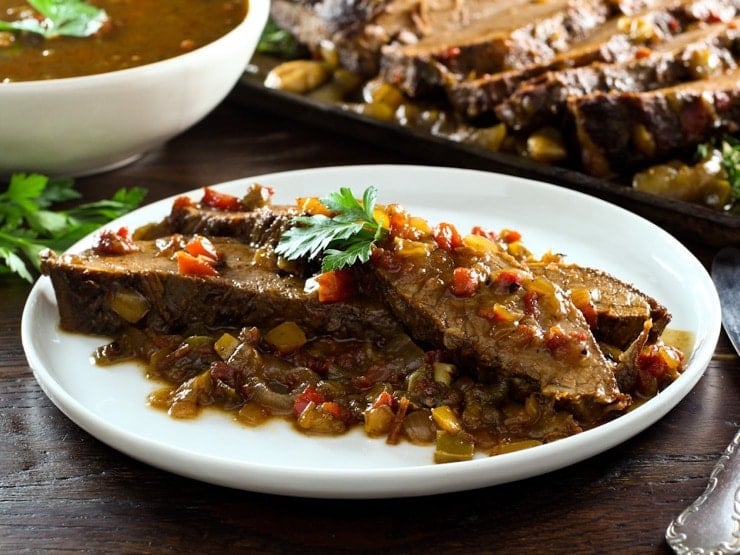
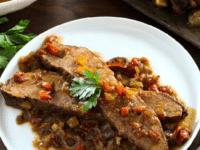
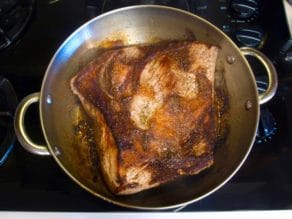
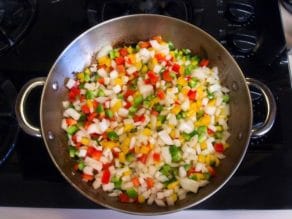
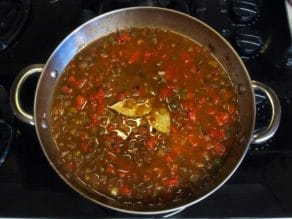
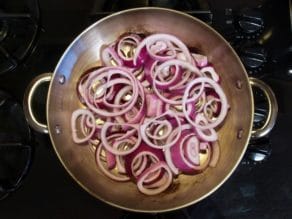
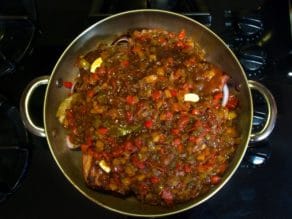
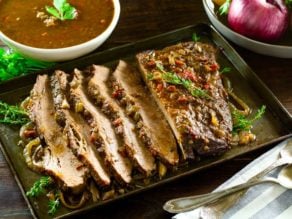
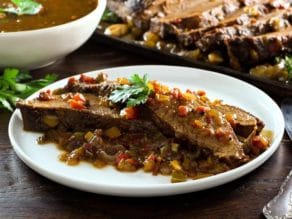


My husband was a little concerned at first with this recipe because it veered from his traditional Jewish brisket. But when I told him Michael’s story, he relaxed and even helped me throughout the process. We had so much fun in the kitchen!
First, let me say this brisket recipe is a pure joy to work with. The spices and ingredients smell like heaven together, and with the beautiful piece of meat I bought from Costco, which I did trim, including removing the fat cap, I knew it would be wonderful. Because we love yellow onions (they’re “traditional”), we incorporate those into the recipe along with slathering high quality tomato paste on the top of the meat before baking. Also, we subscribe to the low and slow method, so we dropped the oven to 250° for the first four to five hours, then 225°at the very end. In total, our 4.5 lb. flat cut took about 5.5 hours to cook. That’s about an hour and 15 minutes per pound.
Our intention was to let the dish cool before putting it into the oven overnight, but before we did, we couldn’t help slicing into it for a taste. Oh my stars in heaven!!! It is, BY FAR, the best brisket either of us has tasted. THIS will be our new Jewish brisket tradition! We cannot wait to serve for Chanukah tonight. The guests in our quarantine bubble will be grateful.
Want to try but a bit concerned with level of spiciness. How spicy is this?? Mouth burning or just slightly hot??
Thanks
It’s flavorful with spices, but the spicy factor is mild to just slightly hot.
I turned this into a vegan recipe, substituting home made seitan for the brisket. Follow Tori’s directions, place a flattened loaf of seitan over the base and add five cups of water. While the “brisket” is stewing, check it on occasion to ensure sufficient liquid for the seitan to expand. Per Tori’s instructions, let it roast for at least 5 hours. Then, you can take out the seitan and cut it the same way you would a brisket. The texture comes near to mimicking a real brisket without the added fat!
Wow, fantastic idea Connie! Thank you so much for sharing, I’m sure it will be of interest to other readers.
I made this recipe for Passover one year. SOOOO GOOOD!!!
I made this fabulous brisket for my Rosh Hashanah dinner in September, and it was so delicious there was literally nothing left at the end of the evening. Not a single scrap of meat (we were so sad not to have leftovers!). Making it again for different friends this weekend and I know they’ll love it too. It’s super-flavorful and meltingly tender. I also just wanted to say I’ve been following Tori’s blog for a little while now and love it. I’m a big food anthropologist too. Thanks for all the inspiration, Tori!
Thanks Rhona! Glad you’re enjoying the site. 🙂
Hi Tori! This sounds DELICIOUS! Thanks so much for honoring my request (I think I suggested it last year), that you post your recipes way before Rosh Hashanah so we can plan. Thank you!! xoxo
You’re welcome! 🙂 Bookmark my Rosh Hashanah index here for next year, it auto-updates with every new recipe I post in each category: https://toriavey.com/rosh-hashanah-recipe-index/
Delicious! Had this served to me at a friend’s house and asked for the recipe. Was in a pinch for time when I wanted to make it for Shabbat so on friday I prepared everything according to instructions except Instead of slow roasting it, I used an instant pot! I put some red onions at the bottom on the rack then the meat and added as much sauce veggie mixture until the max line. Did manual pressure cooker for 60 minutes with natural release of 15 minutes. Let it cool off completely until transferring it to a large Roaster where the other sauce veggies mixture was (I had baked them for 1 hour at 350 F in the oven) and I tell you… this was absolutely delicious looking and the meat was so so tender! Reheated everything in the Roaster (oven 350 F for 2 hours) for shabbat lunch and served it with rice and a salad. Absolutely amazing! Thank you!
So glad to hear that Katherine! Thank you for sharing your pressure cooker modifications.
Hi Tori!
I’ve made so many of your delicious recipes and they all come out amazing. This one I’ve tried twice and can’t seem to get the same result. The brisket always seems dry. I’ve cooked it at @ 220 degrees for 7 hrs and as the recipe states @ 1hr per 1lb @ 300. Any idea what I could be doing wrong? I want to get it right!
Thanks!
Jason
Hi Jason! If you’re using first cut brisket, make sure it’s untrimmed. You need that excess fat to produce moisture as it cooks. When you say dry, it makes me think your brisket may be too lean. This can especially be a problem with grass fed brisket. If you don’t have much choice on the brisket or your butcher won’t give you a fattier cut, add more liquid and let it cook slower and even longer. Grass fed can take a few hours longer than normal brisket. If it seems like there isn’t enough liquid in the pan, you can always add more low sodium broth during cooking to make up for lost moisture. Also any reason you’re cooking it lower than the suggested temp of 300 degrees F? Good luck– hope you nail this one, it’s worth it!
Usually braising is foolproof. Bump your temperature up to 260-270°F. 220°F is too low and will dry it out and never render the tough fibers into tender collagen quickly enough. Use a digital thermometer and pull it when the thickest part of the cut reaches 205-208°F. Remove it, double wrap it in heavy foil and then in towels then place it in a dry cooler, and let it rest for 2 – 4 hours. That’s how you do it for perfectly done smoked brisket. Resting the cut allowing carry-over cooking to do it’s job is the key.
https://www.thespruceeats.com/what-is-connective-tissue-995836
This is one of the best things I’ve ever eaten. (My son and husband made it, I just had to come home and eat!) I served it with brown rice and Paula Shoyer’s Winter Salad. We will be eating this again.
This was amazing. I had to sub out the cinnamon for a family member with an allergy, but I used half as much ground cloves and it worked well. I cooked it in my slow cooler on low for about 5 hours and it was perfect. Thanks for the great recipe…it was some work but it was definitely worth it.
This was delicious! Loved the spices, and the little bit of heat. Even my foodie daughter loved it. When I first read it it looked complicated. Don’t be scared! It’s quite easy. I just made too much brisket, but oh, well- more leftovers. What I really loved was that the ingredients were not anything exotic that needed to be purchased and used once. I had all the spices in my cabinet.
Thanks for this keeper recipe!
Glad you enjoyed it Sara!
Hi Tori!
Gut Yom Tov! Happy Passover!
This recipe looks sooooo good! I’m totally gonna give it a try!
Thanks!
Happy Passover Mona! 🙂
I found this recipe in the Passover link. Brown sugar is not Kosher for Passover, & that’s one of the ingredients in this recipe. What would you use instead?
Hi Carol, there are most certainly brown sugars available that have a kosher for Passover hechsher, you should ask your local kosher market. You can also feel free to substitute white granulated sugar.
Tori, I am a little confused as to how many pans are used for the brisket. After braising, do you remove the brisket from that pan and add the veggies to the pan. Also, is ther a new pan for the onions? Please enlighten, I don’t want to miss-cook the brisket.
Thanks,
Sara G.
Hi Sara- if you have a roasting pan that will heat up on your stovetop, you can use one pan for everything. If your roasting pan won’t heat up on your stovetop due to your burner configuration, you’ll need a skillet for browning the brisket and making the sauce before putting into a roasting pan. The instructions break it down pretty clearly if you walk through it step-by-step. Good luck!
Thanks, Ms. Tori Avey. Appreciate the cooking help.
This sounds sooooo delish. Do you think it can be made in a pressure cooker? Also do you have a gefulte fish recipe that doesn’t use whitefish and pike? Maybe w salmon or cod?
Hi Sam, the trouble with making this in the pressure cooker is that it will create far more liquid than it would during slow roasting or slow cooking. Often recipes like this end up with a very watery sauce due to the vegetables, tomatoes and stock. If you were to try it I would suggest cutting the stock completely; even then you will probably end up with a somewhat weak, watery sauce. Re: gefilte– I haven’t posted any gefilte fish recipes yet. I probably should, it’s just not something I am super excited about. 🙂
This sounds delicious and has tempted me enough to cook brisket for the first time.
But what is “first cut brisket” ? will be buying from non Kosher market, pretty sure they won’t know what I am talking about.
Toda Raba Tori.
Hi Nicola! Most briskets available in the supermarket are first cut. It’s the flatter, leaner cut of brisket. This recipe doesn’t require much fat, because it’s got so much sauce and flavor. Any supermarket butcher should know the difference. Using a second cut won’t hurt, but it will produce a fattier end result.
I love your page and I love Michael Twitty…he is a wonderful man. I am so excited to see your collaboration. He is on a culinary journey in Ghana, I can’t wait to see what he brings back and what you two will cook up next:-) !! Thanks Tori!
Your Lentil-Lemon-Spinach soup has become a family favorite. Sometimes I add sliced fresh mushrooms. It freezes well.
Can this brisket cook in the slow cooker instead of roasting in the oven?
Yes, you would roughly follow the process outlined in this post: https://toriavey.com/toris-kitchen/savory-slow-cooker-brisket/ modifying for the ingredients listed here.